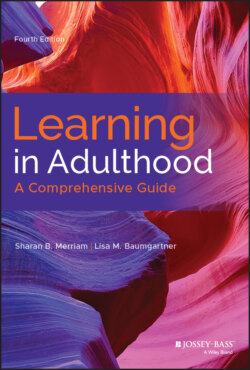Читать книгу Learning in Adulthood - Sharan B. Merriam - Страница 23
Connectivism
ОглавлениеSiemens (2005) posits that connectivism is “a learning theory for the digital age” (p. 1). He says other learning theories do not address learning via technology. In an information-rich, networked world, learners must judge information quickly to assess its importance.
Siemens advances eight principles of connectivism:
1 Learning and knowledge rest in a diversity of opinions.
2 Learning is a process of connecting specialized nodes or information sources.
3 Learning may reside in nonhuman appliances (e.g., a database).
4 Capacity to know more is more critical than what is currently known.
5 Nurturing and maintaining connections is needed to facilitate continual learning.
6 Ability to see connections between fields, ideas, and concepts is a core skill.
7 Currency (accurate, up-to-date knowledge) is the intent of all connectivist learning activities.
8 Decision-making is itself a learning process. Choosing what to learn and the meaning of incoming information is seen through the lens of a shifting reality. Although there is a right answer now, it may be wrong tomorrow due to alterations in the information climate affecting the decision (Siemens, 2005, p. 5).
Connectivism focuses on people learning through networks which are “connections between entities” (p. 4). Knowledge begins with the individual. “Personal knowledge is comprised of a network, which feeds into organizations and institutions, which in turn feedback into the network, and then continues to provide learning to the individual” (Siemens, 2005, p. 6). Remaining current in one's field means remaining connected. Online communities of practice may be an example where connectivism occurs. Personal information about an issue may be gained from those in the group. For example, knowledge about how to cope with the loss of a child may be learned from members in an online grief group. This knowledge could be shared with a larger organization and, in turn, the larger organization could provide the support group more knowledge.
MOOCs are an example of the connectivist learning pedagogy. There are two types of MOOCs. xMOOCs (eXtended MOOCs) are designed by companies that collect student data to improve course design (Harasim, 2017). In contrast, Connectivist Massive Open Online Courses (cMOOCs) place the burden of instruction on the participants themselves. There is no course designer. Instead, “network intelligence… would identify the learner's interests, facilitate the learning connections and respond to a learner's questions and needs” (p. 157). The cMOOC is unstructured whereas the xMOOC is more structured but “both promote teacherless courses in which intelligent networks identify the content and connections, making key decisions for the students” (p. 158).
Critics note that connectivism may not be a new learning theory as its limitations are not discussed (Forster, 2007 as cited in Kop & Hill, 2008). Further, the theory is not empirically tested in a variety of settings. Siemens's statement that older learning theories fail to address technology is not exactly correct. Although online technologies did not exist when behaviorism and cognitivism were presented as learning theories, these learning theories responded to the technology of the time (Harasim, 2017). Harasim observes that the learning theories of the 1900s were shaped by automation as demonstrated by “Pressey's Teaching Machine,” which was a machine based on the behavioristic stimulus–response and was meant to “automate the role of the teacher” (p. 135). Verhagen (2006) asserts that connectivism may influence pedagogy but it is not a new theory because people learn as they always have, but they have to adapt to new technologies (as cited in Kop & Hill, 2008). Other criticisms of the theory include the lack of empirical studies on this approach and no “development of a theoretical framework of how people learn connectivist approaches” (Harasim, 2017, p. 149). Kop and Hill (2008) conclude that connectivism may not be a theory but it “continues to play an important role in the development and emergence of new pedagogies, where control is shifting from the tutor to an increasingly more autonomous learner” (p. 11).
